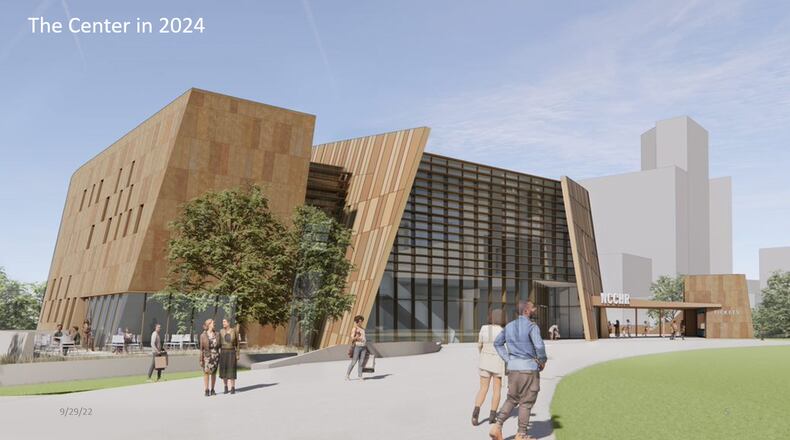The National Center for Civil and Human Rights is planning to mark its 10th anniversary in 2024 with a major expansion, with the help of one of its original supporters.
Philanthropist and business mogul Arthur M. Blank committed $15 million toward the center’s $48 million capital campaign that will add two wings to the downtown museum.
The west wing, which will be three stories, will be named for Blank.
Credit: Center for Civil and Human Rights
Credit: Center for Civil and Human Rights
A groundbreaking ceremony will be held on Oct 14, with the goal of having the expansion done by 2024.
“The story of the National Center for Civil and Human Rights is so important,” Blank said. “Probably never more important now, as we are living in a nation that is very divisive. This is a great center with a great story to tell.”
In addition to his $15 million donation for the physical structure, in 2021, Blank donated an additional $2 million to help fund the center’s “Truth and Transformation” project.
The National Center for Civil and Human Rights opened with great fanfare in 2014 with the mission of inspiring people “to tap their own power to change the world around them.”
Blank was on board from the start and has donated millions to the center. He’s brought members of the Atlanta Falcons and Atlanta United to the center, where he also hosted a dinner for the NFL owners during Super Bowl LIII in 2019.
The center’s civil rights gallery is also named for him.
Credit: HYOSUB SHIN / AJC
Credit: HYOSUB SHIN / AJC
“When he had the owners’ dinner here, he was so proud to showcase this gem of a museum and this city’s history,” said Jill Savitt, who became the center’s CEO in 2019. “He sees the center as telling the unique history of Atlanta.”
Blank said his personal background fuels his interest in the center, as well as his long-standing relationships with people like Ambassador Andrew Young and the late John Lewis.
“This was an opportunity to help bring people together around issues that have not gotten all of the exposure they needed,” Blank said. “When you are talking about human rights and civil rights, it is important to be grounded in history and understand the present.”
The centerpiece of the museum, from day one, has been the selection of Morehouse College Martin Luther King Jr. Collection of papers displayed in the Voice to the Voiceless Gallery.
Credit: Bob Andres
Credit: Bob Andres
The collection, more than 10,000 papers and books spanning from 1944 to 1968, was acquired in 2006 for $32 million with the help of former Atlanta Mayor Shirley Franklin, who didn’t want them split up at auction. The collection was donated to Morehouse after the purchase.
The $75 million, 42,000 square feet center, built with private and public money, is in the heart of the evolving tourist corridor, sharing Pemberton Place with the World of Coca-Cola and the Georgia Aquarium. The College Football Hall of Fame is a football toss away, as is Centennial Olympic Park.
Credit: Bob Andres
Credit: Bob Andres
Savitt said the center has raised $27 million toward what was originally a $38 million project. Escalating costs have added about another $10 million to the project.
Aside from the Arthur M. Blank Foundation, the Wilbur and Hilda Glenn Family Foundation donated $5 million.
The James M. Cox Foundation was one of several organizations that donated $1 million, including the AEC Trust, Home Depot and UPS.
Savitt said the expansion will take the center in new directions while positioning it to compete with local attractions and to establish a global brand.
“We have perfected how to be an attraction to Atlanta, and we are making a strategic shift to become a national cultural institution focused on rights, with exhibitions,” Savitt said.
As part of the expansion, the gallery that displays the selection of MLK papers will move from the lowest level to the lobby level at the facility’s entrance. The civil rights gallery and the human rights gallery will both get refurbished.
A new one-story east wing will have classrooms and spaces for large-scale dinners and conferences.
Credit: Center for Civil and Human Rights
Credit: Center for Civil and Human Rights
But the west wing, Savitt said, could be a game-changer.
Along with a cafe on the first floor, the wing will include a gallery focusing on racial violence.
The wing also will have a gallery devoted to families and children. Blank lamented the fact that the center is in a plaza with the World of Coke and the Georgia Aquarium, yet it has very little to offer children that isn’t tied to graphic and sober images of violence.
The new gallery will use creative ways to engage and teach children about the legacy of civil and human rights, Savitt said.
Right now, Savitt said, there’s “nothing for a 9-year-old to really do here. This changes that.”
About the Author
The Latest
Featured








